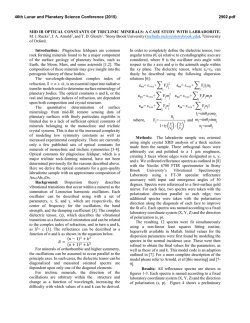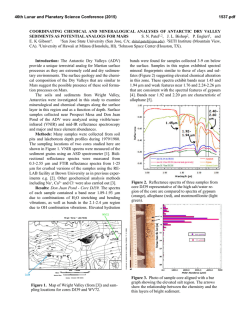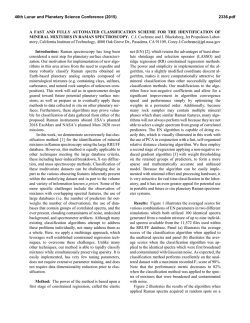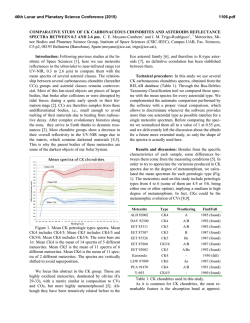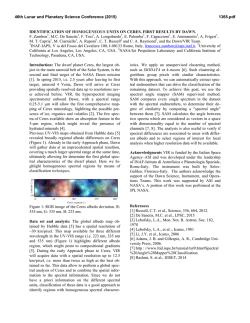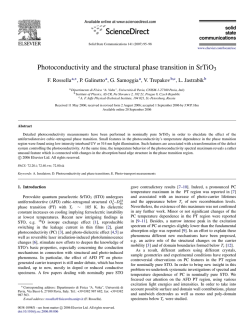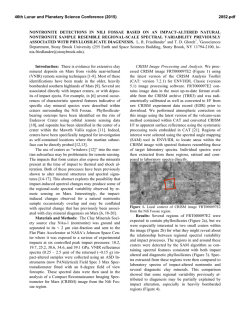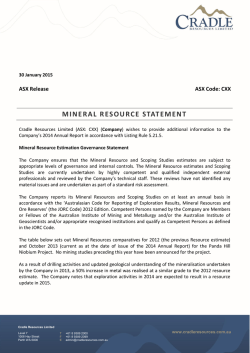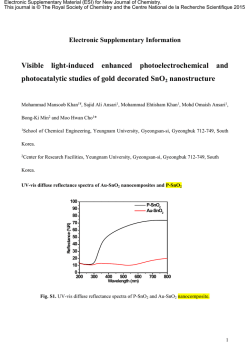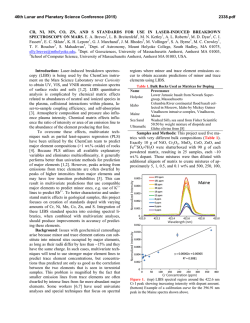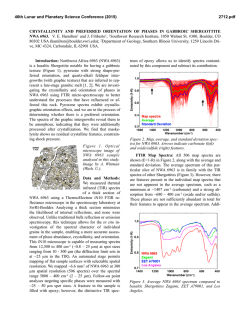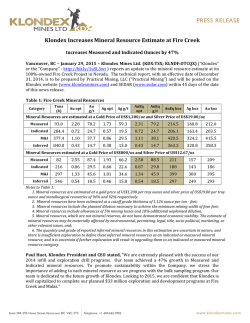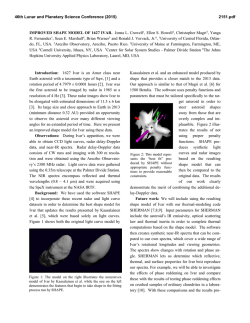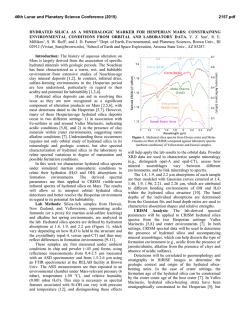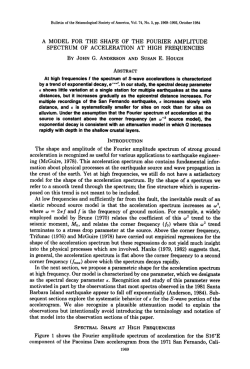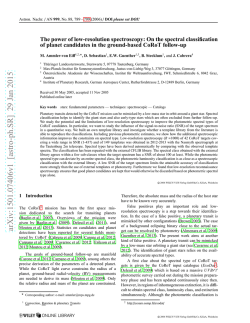
Identification and Quantification of Mineral Abundance from VSWIR
46th Lunar and Planetary Science Conference (2015) 1689.pdf IDENTIFICATION AND QUANTIFICATION OF MINERAL ABUNDANCE FROM VSWIR REFLECTANCE SPECTRA IN CARBONATE/SERPENTINE SYSTEMS. E. K. Leask1 and B. L. Ehlmann1,2, 1 Division of Geological and Planetary Sciences, California Institute of Technology, MC 170-25, Pasadena, CA, 91125. (Email: [email protected]), 2 Jet Propulsion Laboratory, Pasadena, CA. Introduction: Visible/shortwave infrared (VSWIR) reflectance imaging spectroscopy is a useful tool for mineral identification as it is non-destructive, does not require intensive sample preparation, and is directly relatable to remote sensing data at coarser spatial scales. In the field (and on landers/rovers), it can be used to identify targets of mineralogical interest and provide information about small-scale mineralogical variability, including alteration textures and assemblages [1]. Data from the prototype UltraCompact Imaging Spectrometer (UCIS) in microspectrometer mode are used to identify and estimate abundances of mineral phases, focusing on identification and differentiation of carbonate phases. Rock samples from the Samail Ophiolite (Oman) [2] are analyzed as an analogue for carbonate environments on Mars [3]. Samples are from different parts of the ophiolite sequence and are predominantly mixtures of serpentines and carbonates. An overarching goal of this work is to establish methods of quantifying carbonate content, at multiple spatial scales, with VSWIR data [4]. Methods: Data Collection. Cut surfaces of rock samples were illuminated and imaged with UCIS. A single pixel footprint of about 81 μm spectrally samples every 10 nm between 500 and 2500 nm [1]. Spectra are calibrated against a white reference spectralon panel, set at the same distance from the sensor. X-ray diffraction patterns of ground bulk rock samples were collected to provide independent verification of mineral identity and abundance; examination of petrographic thin sections allows a third method for mineral identification, as well as interpretation of textural relationships between mineral phases. Elemental mapping using an electron microprobe will be performed for a direct quantitative comparison. Grouping and Mapping Spectra. Two methods for mineral mapping from UCIS images have been employed to date: supervised classification through endmember collection, using built-in ENVI (Excelis Visual Information Solutions software) routines, and creation of band parameters to spatially map absorption features. In the first case, endmembers are chosen which capture the spectral variability within the image. Mean spectra over regions of interest (e.g., Fig. 1) representative of each endmember are determined. Then the image is classified using ENVI’s minimum distance supervised classification. To map using band parameters, the location of frequently-occurring absorptions are noted. Band depths are calculated by subtracting the absolute reflectance of a band from the assumed continuum level, estimated through linear interpolation from the left and right hand shoulders of the absorption [5]. Electronic absorptions due to transition metals (500 nm and 680 nm) and vibrational absorptions by water molecules bound in or adsorbed by minerals (1460, and 1940 nm) have been mapped [6, 7] (Fig. 2). Results and Discussion: Supervised Classification using End Member Spectra. A serpentine pebble conglomerate in a carbonate matrix is imaged in Figure 1. Regions of interest are averaged for the end member spectra (Fig 1A); corresponding mean spectra are shown in Fig. 1C. Supervised classification using these endmembers (Fig. 1B) separates the minerals into three groups: (A) blue members in clast centers; (B) green members replacing or around the edges of clasts; and (C) Figure 1: Mapping areas of spectral similarity based on selected endmembers; purple tones in the matrix. sample is a serpentine conglomerate in a carbonate matrix. A) False color Textures observed in this sample are image highlighting spectral diversity; polygons define the regions averaged for likely a result of alteration, also evident endmember spectra. B) Result of minimum distance supervised classification in ENVI. C) Averaged endmember spectra from (A), with USGS reference spectra. in petrographic thin section. Group A 46th Lunar and Planetary Science Conference (2015) and some Group B members show absorptions around 910-950 nm, similar to pyroxene (Fig. 1C). Cyan and blue both have low albedo, and minimal absorptions at 1400 and 1900 nm, indicating they are least altered. The dark green endmember’s spectrum is very similar to the USGS reference spectrum for antigorite, a serpentine, and the light green has characteristics of both pyroxene and antigorite, implying alteration or mixing at <81 µm scale. Absorptions at 2.16 and 2.34 μm in the dark magenta region are likely caused by calcite’s Ca-CO32bonds [8]. The lighter pink region has very high albedo expected of carbonate minerals, although its spectral shape is more similar to lizardite than calcite or magnesite, with a very deep, asymmetric absorption at 1.9 μm (Fig. 1C). In thin section, the matrix is very fine-grained with some cloudiness; calcite may be intermixed with extremely fine-grained serpentine. Microprobe results should help to answer this question, as analyses can be performed on a 5-10 μm scale. Band Parameter Threshold Classification. Figure 2 demonstrates the band parameter method on a magnesite vein sample. Fig. 2A shows a true color image of the sample. Fig. 2B combines 3 band parameters to highlight areas with different absorption features. Colored regions in Fig. 2C come from threshold values on similar parameter maps for absorptions at 500, 680, and 1940 nm. Mean spectra for each region are similar to Figure 2: Mapping areas of spectral similarity based on band parameter thresholds. A) True color image of magnesite sample. B) False color image using band depth parameters. C) Colored regions based on band depths (High, low, or moderate absorption). D) Mean spectra from regions in (C), with USGS reference spectra. 1689.pdf magnesite overall, with a major absorption at 23002310 nm [8]. Absorptions at 1.4 and 1.9 μm are likely due to H2O. The orange region absorbs strongly at ~700 nm and shorter wavelengths, while the light green region only absorbs strongly at wavelengths shorter than ~600 nm, indicating that these regions contain different minerals. Green and orange areas are concentrated along fractures, in cavities, and at the surface. Blue regions are based on different strengths of water-related absorptions at 1.4 μm and 1.9 μm. The strength of these water-related absorptions may be related to the water content of the sample, but may also be a result of varying path length (e.g. larger fluid inclusions in larger grains). Interior parts of the sample map as cyan (strongest water absorptions), surrounded by a rim of darker blue material with weaker waterrelated absorptions. Microprobe work should reveal whether the difference is due to grain size, or if there is a change in volatile content (estimated by missing mass) between the blue tones. Conclusions and Future Work: UCIS hyperspectral images can map mineralogical variation on the scale of ~80 μm, tracing small veins, alteration textures, and differences in grain size. Mineralogical units are presently defined on the basis of spectral characteristics, corresponding to particular endmembers. We will work to (1) improve mineral identification of each unit using spectral data; (2) calculate areal percent abundances, and (3) perform microprobe mapping to provide a direct comparison with IR image maps. Direct quantitative comparison will allow spectral differences caused by grain size changes to be separated from those caused by changing mineralogy and/or coatings. Images of this type taken on Mars would resolve changes in fluid chemistry over time, as veins filled with different minerals are identified. Detailed mineral assemblages and textures would narrow down possible temperature, pressure, and chemical conditions. If these spectral signatures and mineralogical textures can be tied to quantitative mineral abundances, modal abundances can be used as tests for geochemical models and volatile reservoirs can be catalogued. Obtaining this kind of data about Martian systems would significantly improve our understanding of past environments and alteration processes on Mars, which are intimately related to the presence of water on Mars. References: [1] Van Gorp B. et al. (2014) J. Appl. Rem. Sens. 8, 084988 1-15. [2] Keleman P. B. & Matter J. (2008), PNAS, 105, 17295-17300. [3] Ehlmann B. L. & Mustard J.F, (2012) GRL, 39, L11202 [4] Ehlmann B. L. et al. (2012) LPSC 43, abs 1471. [5] Pelkey S. M. et al., (2007), JGR, 112, E08S14. [6] Bishop J. L. et al. (2008) Clay Minerals, 43, 35-54. [7] Morris R. V. et al. (2000) JGR, 102, 1757-1817. [8] Gaffey S. J. (1987) JGR, 92, 1429–1440. Acknowledgements: Thanks to the NASA Mars Fundamental Research program (NNX12AB42G) for support.
© Copyright 2026

